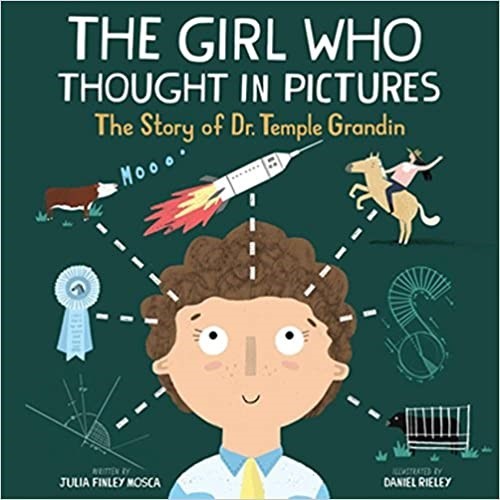“I am different, not less”
Both children with autism and children without it need to understand that autism is a difference, not a problem. To share that message with the children in your life, check out The Girl Who Thought in Pictures: The Story of Dr. Temple Grandin, by Julia Finley Mosca.
Because she hadn’t started speaking by age two, doctors diagnosed Temple Grandin with brain damage. Even when that was corrected to a diagnosis of autism, doctors suggested that her parents should send her to a special home. With speech therapy, she began speaking around age four. But she continued to face challenges making conversation, reading facial expressions, and fitting in. She endured bullying at school and at age fourteen she lost her temper and threw a book at another student. She was asked to leave her school and never come back. Luckily, the time she spent the following summer on her aunt’s ranch changed her life. She realized she had a deep connection with animals. When she returned to school, she found support from a teacher who recognized her gifts, encouraged her, and helped her develop a love of science. Since then, she’s earned a PhD in animal science, and spent her career studying how to treat animals more humanely and pushing the meat industry to use her procedures. She has also worked to improve the lives of children with autism, encouraging intervention and support systems as well as giving talks to inspire and motivate children.
This is a book aimed at younger readers. It’s best for children 0-7 years old. The life story of Temple Grandin is presented here in rhyming verse and many engaging illustrations. It begins with Temple being diagnosed with autism, bullied and alone. It then progresses through her rediscovery of herself and her ability to help animals through science. The story ends with a message of her success, and encouragement that the reader can succeed, too. The book doesn’t end there, though; there’s a short encouraging letter and photo from Temple herself, some fun facts about Temple’s life and abilities, a timeline of her life, and a more fact-filled 2-page biography aimed at older readers (adults).
This book would make a great addition to elementary classrooms and libraries, since all children need to understand that being different isn’t bad. It would be great encouragement to any child on the neurodiversity spectrum or who feels different / left out for any reason. It’s also a good reminder that science can be applied to improve all parts of life: people thinking of science often think of space or chemistry or other things not found in a typical home, but Temple Grandin applied her skills to farms and animals and everyday needs.
Find The Girl Who Thought In Pictures: The Story of Dr. Temple Grandin on Amazon at https://www.amazon.com/dp/1943147302/.
For reviews of other children’s books featuring diversity in technology and engineering, see STEM Area: Technology and STEM Area: Engineering.
For reviews of other children’s books featuring gender and racial diversity in STEM, see Diversity Type: Gender.
For reviews of other books that are great for the 6-8 age range, see Age Group: 6-8.
Also see our full STEM listings of books and other resources that feature diversity in STEM.





